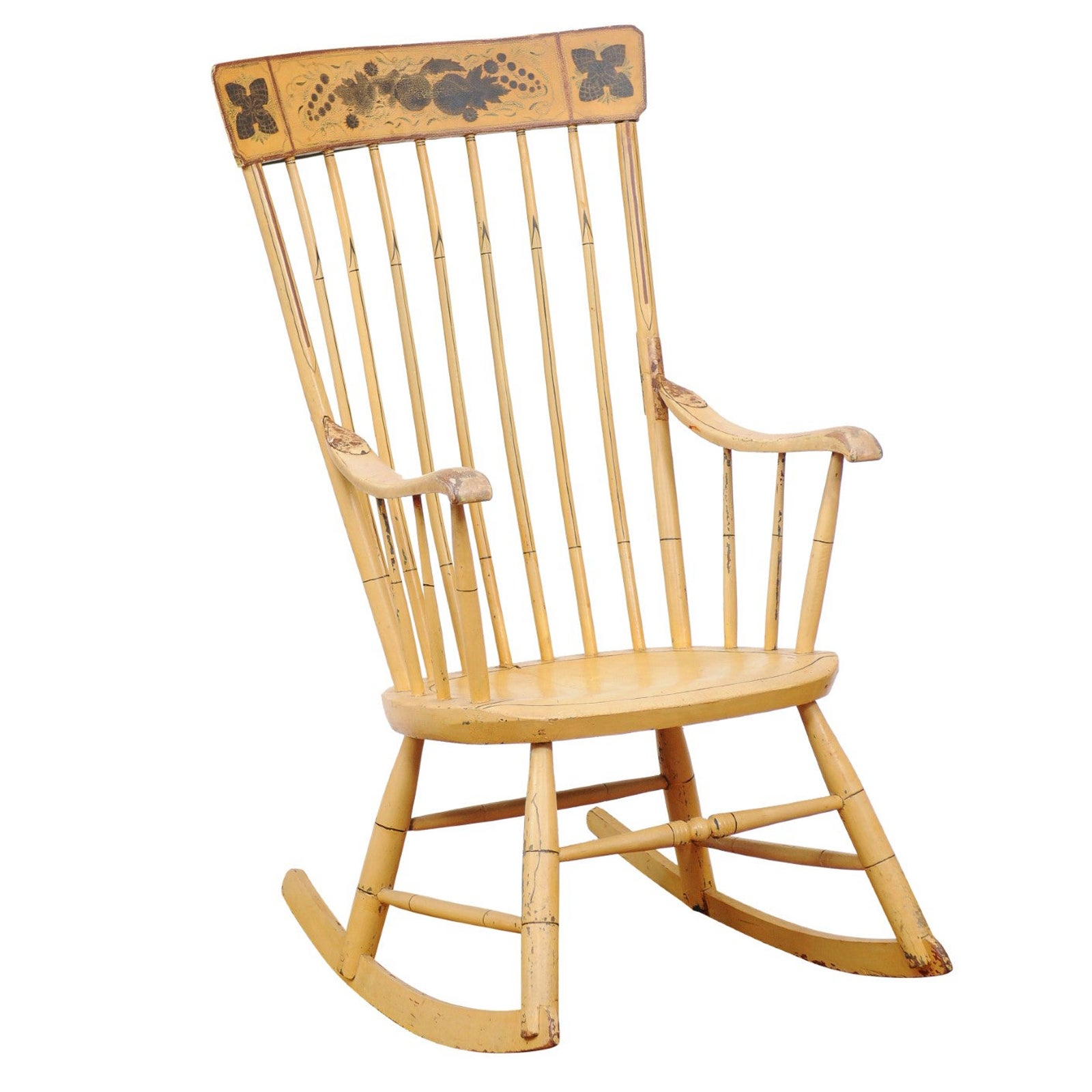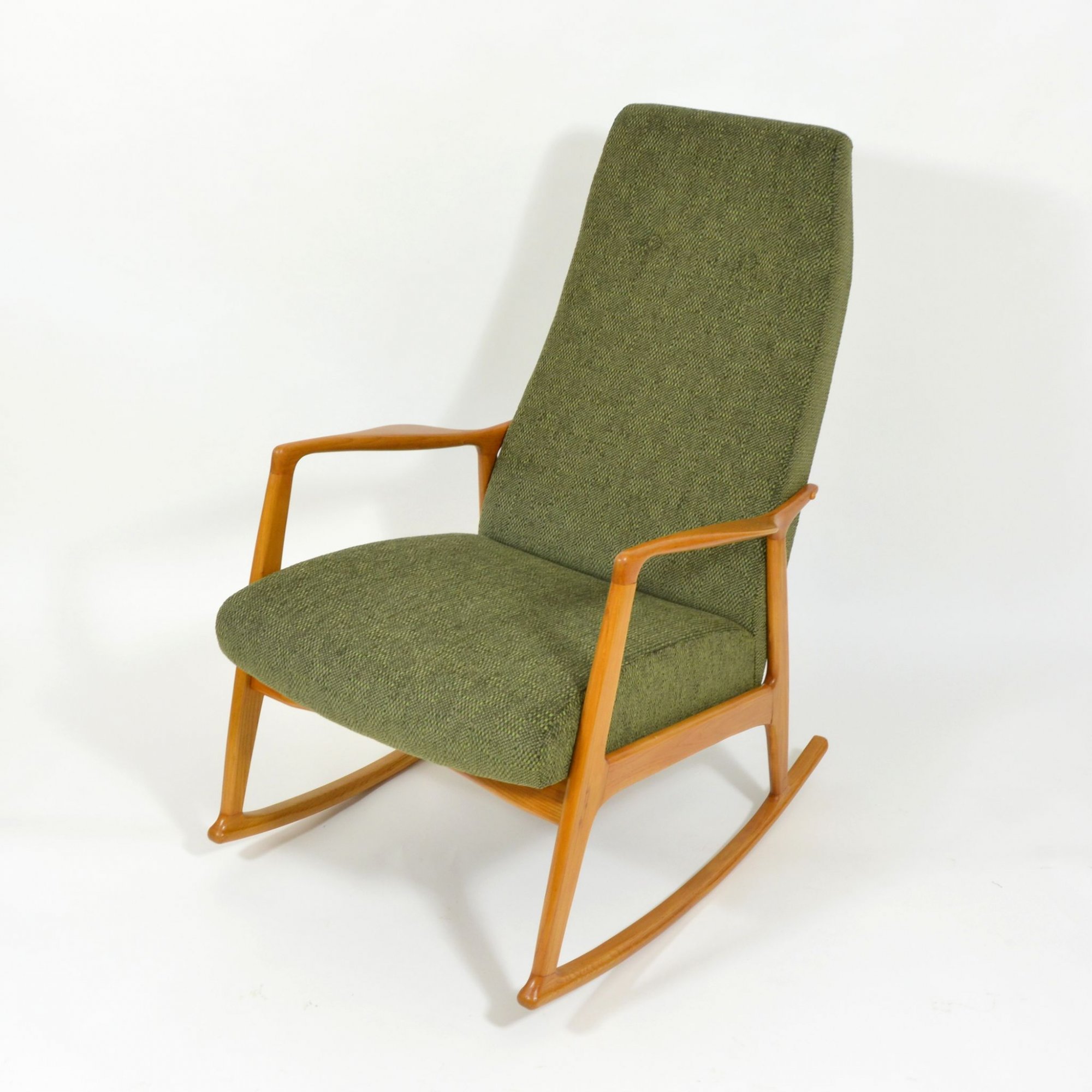Historical Context of Green Rocking Chairs

The comforting sway of a rocking chair, often painted a calming green, speaks to a rich history interwoven with design evolution, cultural significance, and material innovation. From humble beginnings to iconic status, the green rocking chair has occupied a unique space in homes and hearts across generations.
The evolution of rocking chair design is a fascinating journey, with green hues appearing throughout various periods. Early rocking chairs, often crafted from simple wood, lacked the sophisticated paint jobs of later eras. As manufacturing techniques improved and paint became more accessible, green – a color associated with nature, tranquility, and even prosperity – became a popular choice, reflecting the evolving tastes and social contexts of different times.
The Social and Cultural Significance of Green Rocking Chairs, Vintage green rocking chair
Rocking chairs have held symbolic weight throughout history, representing relaxation, contemplation, and the domestic sphere. Their presence in art, literature, and photography often underscores themes of comfort, family, and the passage of time. Grandma’s green rocking chair on the porch, for example, frequently appears in nostalgic depictions of simpler times, evoking feelings of warmth and security. The color green itself, often associated with nature and peace, enhances this imagery. Literary works frequently feature rocking chairs as symbols of quiet reflection or a character’s state of mind. Similarly, photographic portraits often include rocking chairs to create a sense of place and time. The iconic image of a woman in a green rocking chair, knitting by a window, immediately conjures up feelings of domestic tranquility and a bygone era.
Materials Used in Vintage Green Rocking Chairs
The materials used in vintage green rocking chairs varied significantly depending on the era and the chair’s intended use. Early rocking chairs were often constructed from readily available hardwoods such as oak, maple, or cherry. As manufacturing processes advanced, other woods, including less expensive options, were employed. Upholstery, when present, also changed over time. Early chairs might feature simple woven fabrics, while later examples incorporated plusher materials like velvet or patterned textiles. The green paint or finish itself also evolved, reflecting the changing availability and technology of paint production. Early paints might have been less durable, while later paints offered increased longevity and a wider range of shades.
A Timeline of Notable Green Rocking Chair Designs and Manufacturers
While pinpointing specific manufacturers of green rocking chairs across history is difficult due to limited record-keeping, a general timeline can be constructed.
Early 1800s – 1900s: Simple wooden rocking chairs, often painted with basic green paints, become increasingly common in American homes. The focus is on functionality and practicality.
Early to Mid 1900s: Mass production leads to a wider variety of styles and materials, including the use of different woods and more sophisticated paint techniques, resulting in richer and more varied shades of green. Manufacturers like Heywood-Wakefield produced many rocking chairs, although specific models with green finishes are difficult to definitively document.
Late 1900s – Present: Antique and reproduction green rocking chairs gain popularity as collectors’ items and as symbols of nostalgic Americana. The color green continues to be a popular choice, reflecting its enduring appeal.
The specific shades of green, the wood types, and the upholstery styles varied greatly throughout this period, reflecting changes in fashion, technology, and materials availability. The enduring appeal of the green rocking chair lies in its ability to seamlessly blend into various aesthetic contexts while maintaining its comforting presence.
Identifying and Appraising Vintage Green Rocking Chairs

Unlocking the secrets of these charming antiques requires a keen eye and a touch of detective work. Understanding the nuances of style, construction, and condition is key to both identifying and accurately appraising a vintage green rocking chair. This process blends historical knowledge with practical assessment, allowing you to appreciate the chair’s unique story and potential value.
Identifying Authentic Vintage Green Rocking Chairs
Authenticity is paramount when dealing with vintage items. Several clues can help distinguish genuine antique rocking chairs from reproductions. Examine the construction techniques: hand-carved details, mortise-and-tenon joinery, and the overall craftsmanship speak volumes about age and authenticity. Look for maker’s marks, stamps, or labels, which can pinpoint the manufacturer and sometimes even the date of production. Researching known manufacturers of the period—such as those specializing in Victorian, Arts & Crafts, or Mid-Century Modern styles—is crucial for verifying authenticity. Consider the wood type; hardwoods like oak, cherry, or mahogany were commonly used, indicating higher quality and potential value. The patina of the paint—subtle variations in color and texture acquired over time—can also be a strong indicator of age. Finally, inconsistencies or imperfections are often hallmarks of handmade pieces, unlike the uniformity seen in mass-produced reproductions.
Assessing Condition and Value
The condition of a vintage green rocking chair significantly impacts its value. Carefully inspect the chair for wear and tear, noting any cracks, chips, loose joints, or significant damage to the wood or finish. Assess the integrity of the rockers; are they sturdy and well-attached? Examine the upholstery (if present) for wear, tears, or fading. The originality of the chair is another critical factor; restorations, while sometimes necessary, can diminish value if not expertly done. A chair in excellent, original condition, with minimal wear and tear, will command a significantly higher price than one requiring extensive repairs. Consider the overall aesthetic appeal; a well-preserved chair with a pleasing patina will be more desirable. Online resources, auction records, and antique dealer expertise can provide valuable comparative data for estimating value. For example, a well-preserved Victorian rocking chair in original green paint could fetch several thousand dollars, while a similar chair requiring significant restoration might sell for a fraction of that price.
Styles and Variations of Vintage Green Rocking Chairs
Vintage green rocking chairs span various styles, reflecting the evolving tastes and manufacturing techniques of different eras. Victorian rocking chairs, for instance, often feature ornate carvings, curved lines, and plush upholstery. Arts & Crafts rocking chairs tend to be simpler in design, emphasizing natural materials and handcrafted details. Mid-Century Modern rocking chairs often showcase clean lines, geometric shapes, and a focus on functionality. The color green itself can vary widely, ranging from deep forest green to lighter, more pastel shades, reflecting the prevailing color palettes of each era. These variations in style, material, and color significantly impact a chair’s desirability and, consequently, its value.
Comparison of Vintage Green Rocking Chair Styles
| Style | Key Features | Typical Materials | Approximate Value Range |
|---|---|---|---|
| Victorian | Ornate carvings, curved lines, often upholstered | Mahogany, oak, cherry; often with fabric upholstery | $500 – $5,000+ (depending on condition and maker) |
| Arts & Crafts | Simple, handcrafted design, emphasis on natural materials | Oak, ash, or other hardwoods; sometimes with leather upholstery | $300 – $3,000+ (depending on condition and maker) |
| Mid-Century Modern | Clean lines, geometric shapes, often molded plywood | Plywood, molded plastic; sometimes with vinyl upholstery | $100 – $1,500+ (depending on designer and condition) |
| Shaker | Simple, functional design; straight lines, minimal ornamentation | Hardwoods like maple or cherry; usually un-upholstered | $200 – $2,000+ (depending on condition and maker) |
Restoration and Preservation of Vintage Green Rocking Chairs

Breathing new life into a vintage green rocking chair is a rewarding endeavor, blending careful preservation with skilled restoration. The process requires patience, attention to detail, and a respect for the chair’s history. By understanding the materials and techniques involved, you can ensure your chair remains a cherished heirloom for generations to come. This section details the methods and materials necessary for successful restoration and preservation.
Cleaning and Maintaining a Vintage Green Rocking Chair
Regular cleaning is crucial for preventing damage and preserving the original finish. Begin by gently dusting the chair with a soft brush or cloth to remove loose dirt and debris. For more stubborn dirt, use a slightly damp cloth and mild soap, avoiding harsh chemicals that could damage the finish. Always test any cleaning solution on an inconspicuous area first. After cleaning, allow the chair to air dry completely before applying a protective polish or wax specifically designed for wood furniture. This will help to protect the finish and enhance its luster. Avoid placing the chair in direct sunlight or near heat sources, as this can cause the wood to dry out and crack. Regular dusting and occasional polishing will keep your chair looking its best.
Repairing Common Damage to Vintage Green Rocking Chairs
Cracked wood, worn upholstery, and loose joints are common issues with vintage rocking chairs. Cracked wood can often be repaired using wood glue and clamps. Clean the crack thoroughly, apply glue to both surfaces, and clamp them together firmly until the glue dries completely. For more extensive cracks, wood filler may be necessary. Worn upholstery can be replaced by a professional upholsterer or, for those with experience, using new fabric and following a detailed tutorial. Loose joints can be tightened by carefully re-gluing them and reinforcing them with wood screws or dowels. Remember to use wood glue appropriate for the type of wood in your chair.
Refinishing a Vintage Green Rocking Chair
Refinishing a vintage green rocking chair allows you to restore its original beauty or create a new look. The process begins with stripping the old finish. This can be done using chemical strippers, following the manufacturer’s instructions carefully, or by carefully sanding with various grits of sandpaper, starting with a coarser grit and progressing to finer grits. Always wear appropriate safety gear, including gloves and a respirator, when using chemical strippers. Once the old finish is removed, sand the wood smooth. Then, apply a new finish, such as paint, stain, or varnish, in thin, even coats, allowing each coat to dry completely before applying the next. Finally, apply a protective topcoat to seal the finish and protect the wood.
Necessary Tools and Materials for Restoring a Vintage Green Rocking Chair
Proper tools and materials are essential for a successful restoration. The specific requirements may vary depending on the extent of the damage and the desired finish. However, a basic toolkit should include:
- Soft brushes and cloths for cleaning
- Mild soap and water
- Wood glue
- Clamps
- Wood filler
- Sandpaper (various grits)
- Chemical stripper (optional)
- Safety glasses and respirator
- Paintbrushes or spray gun
- Wood stain or paint
- Varnish or sealant
- Upholstery fabric and tools (if needed)
- Screwdrivers and other tools for repairing joints
Remember, restoring a vintage green rocking chair is a labor of love. Take your time, and enjoy the process of bringing this piece of history back to its former glory.
